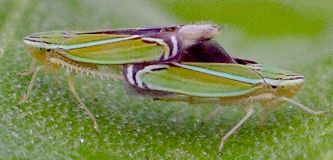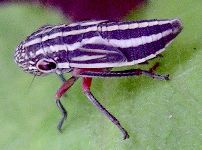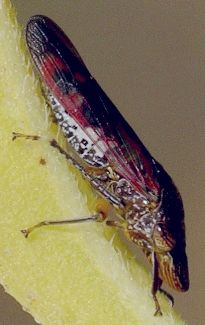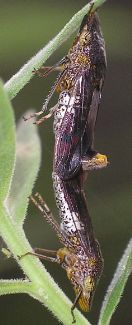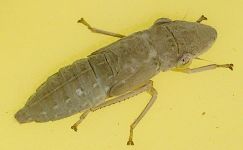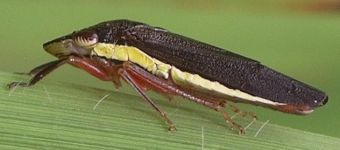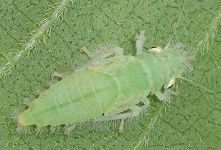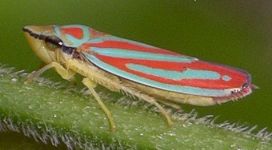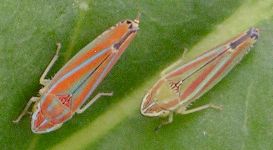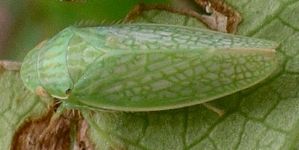
| Cicadellidae ~ Leafhoppers |
page 1 ![]() page 2
page 2
|
Leafhoppers are our most numerous small jumping bugs seen on plants. They can both jump and fly efficiently and are usually rather wary, hiding or fleeing at the slightest disturbance. Size ranges from extremely tiny at 2 mm to about 10 mm, which looks humongous by comparison. Another common name for many leafhoppers is Sharpshooter. The main way leafhoppers are distinguished from other kinds of "hoppers" such as planthoppers and treehoppers is by the very long and spiny hind tibias and the bullet shape of the body.
Mating behavior in this family can often be seen, partly because there are just so many of these insects. They always mate back to back, and it usually looks pretty awkward, as the wings sometimes get in the way, as demonstrated in the illustration of Sibovia compta. Neokolla dolobrata has a charming mating-related behavior in which the female and male sit side by side. I find them this way far more often than seeing them actually mating. This behavior also illustrates the gender differences between the males and females. In this species, males are not only smaller, but darker blue to almost black. The females range from light blue to light brown. Though small, leafhoppers are often easy to identify because of their distinctive markings, shapes, and colors. They can be gaudy or cryptic, and there are only a few species that are so variable that it makes identification difficult.
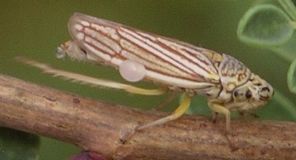 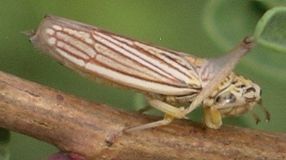 Neokolla uhleri applying brochosomes to its wings Female leafhoppers are often seen with chalky white lumps on their wings. These odd features are mounds of a waxy secretion called egg brochosomes and are produced by the Malpighian tubules, which are insect excretory organs similar in function to a mammal's kidneys. Brochosomes are produced by most leafhoppers and the insects use the substance to coat their bodies, much as birds use oil to waterproof their feathers. They use their long hind legs to help spread a droplet all over their wings. A more specialized use of the material is as an egg cover; females cache the brochosomes in round piles on their wings and use specialized spines on their back legs to rub them off and spread the stuff over a leaf once they have inserted eggs, forming a protective coating.
There are a number of rather easily identified species in our area, but many more are only easy to recognize to the genus level. One of the larger kinds of leafhoppers, which is present much of the year, is a species in the genus Cuerna. Large, in this case, means about 6 mm long. The nymphs are very attractive with contrasting black and white stripes. The adults are also pretty; they have very fine stripes and a red line on each side.
Some of our largest leafhoppers are in the genus Homalodisca, of which H. vitripennis is the most common. These are the Glassy-winged Sharpshooters, named either because of their bullet-like appearance and ability to launch themselves instantaneously, or because they sometimes expel honeydew from their back ends so forcefully that it makes a popping noise as the droplet shoots out. H. vitripennis is variable in appearance: their wings are only partly clear and have either red and/or black markings on them. Nymphs are usually a grayish color. This species is the most likely to be noticed with white brochosomes stashed on the female's wings. The other Homalodisca species sometimes encountered is H. insolita, a striking black insect with a classy yellow stripe down each side. These tend to be more easily frightened than H. vitripennis and will fly away if disturbed.
A species with similar shape and size to Homalodisca is Paraulacizes irrorata. This leafhopper has light speckles all over it. The nymphs are fringed and have strange-looking white eyes.
One of the weirder looking leafhoppers is Oncometopia clarior. Their body is yellowish and the head is quite large, giving it the appearance of having a huge and bulbous nose. The wings can be light blue, violet, or pink. With such striking colors, these rather large leafhoppers (10-11 mm long) are easy to notice, but they are not too common.
The genus Graphocephala contains some of the most delightfully colored species. G. coccinea has contrasting red and blue stripes. It is small (about 4 mm long) but the colors are almost unreal and so it is often noticed. The related Graphocephala versuta is a little bit smaller and can be recognized by the zigzag pattern at the tips of the wings. As with most species in this genus, the colors can be rather variable.
Gyponana contains several similar species, all of which have a green color with a darker green network pattern. They have rather flattened and rounded heads and are usually about 5 mm long. I've been able to identify Gyponana querci but we also have another species that I've not been so successful with.
|
page 1 ![]() page 2
page 2
![]()
